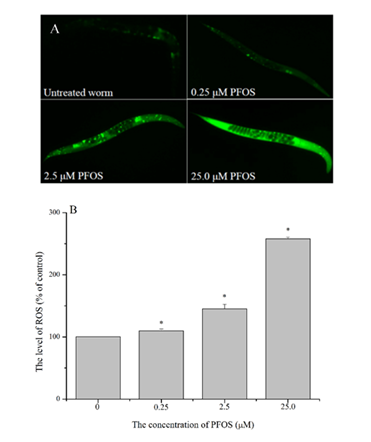
Perfluorooctane sulfonate (PFOS), a common persistent organic pollutant, was reported to show potential developmental toxicity in many animal studies. However, little is known about its effects on reproductive tissues, especially in the germ line.
A study team led by Prof. WU Lijun in Institute of Technical Biology & Agriculture Engineering, Hefei Institutes of Physical Science (CAHIPS), has made great progress in investigating the mechanism of reproductive toxicity of C.elegans, which is induced by PFOS. The paper entitled Perfluorooctane sulfonate exposure causes gonadal developmental toxicity in Caenorhabditis elegans through ROS-induced DNA damage was published in Chemosphere.
In their study, Caenorhabditis elegans was used as an in vivo experimental model to study the developmental toxicity caused by PFOS exposure, especially in the gonads. PFOS exposure significantly retarded gonadal development, as shown by the increased number of worms that remained in the larval stages after hatched L1-stage larvae were exposed to PFOS for 72 h. Investigation of germ line proliferation following PFOS exposure showed that the number of total germ cells reduced in a dose-dependent manner when L1-stage larvae were exposed to 0–25.0 μM PFOS. PFOS exposure induced transient mitotic cell cycle arrest and apoptosis in the germ line.
Quantification of DNA damage in proliferating germ cells and production of reactive oxygen species (ROS) showed that distinct foci of HUS-1::GFP and ROS significantly increased in the PFOS-treated groups, whereas the decrease in mitotic germ cell number and the enhanced apoptosis induced by PFOS exposure were effectively rescued upon addition of 2.0% dimethyl sulfoxide (DMSO) and 5 mM mannitol (MNT).
These findings suggest that ROS-induced DNA damage may play a pivotal role in the impairment of gonad development indicated by the reduction in total germ cells, transient mitotic cell cycle arrest and apoptosis.
This work was supported in part by grants from Major National Scientific Research Projects, Strategic Leading Science & Technology Program (B), National Natural Science Foundation of China grants, CASHIPS director’s fund.

Figure 1. PFOS induced slower germ cell proliferation. (Image by LI Qingqing)

Figure 2. ROS play an important role in DNA damage induced by PFOS exposure (Image by LI Qingqing)

86-10-68597521 (day)
86-10-68597289 (night)

52 Sanlihe Rd., Xicheng District,
Beijing, China (100864)

